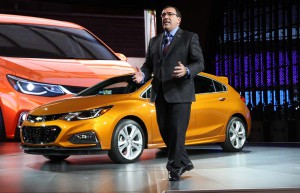Seven years after Detroit’s auto industry nearly collapsed, officials at the two largest domestic makers are taking pains to assure investors they will not only survive but thrive during the next big economic downturn.
Fears that the U.S. car market has peaked after hitting record sales of 17.5 million vehicles last year has made Wall Street increasingly wary, driving down the share prices for all the domestic makers, even as they report strong profits. But two top General Motors and Ford executives painted very different pictures for investors as the New York Auto Show opened to strong public attendance.
“We believe the market is eventually going to plateau, but not in the immediate future,” declared Alan Batey, president of GM North America, during the annual Automotive Summit sponsored by Bank of America Merrill Lynch. And even if sales do take a tumble, he stressed, “We have reduced our break-even point to between 10 million and 11 million annual sales for the industry.”
GM’s long-term viability remains a much-debated issue even seven years after it struggled through bankruptcy, dropping half of its North American brands in the process, and emerging a much smaller company. A much more nimble company, according to Batey.
(Click Here for complete coverage of the 2016 NY Auto Show.)
What, for the auto industry, was a full-on depression led two of Detroit’s three makers to declare bankruptcy, GM and Chrysler surviving only with the help of federal bailouts. The third maker, Ford Motor Co., survived without a handout, but it went so far as mortgaging its Blue Oval logo to ensure it had the cash to get through the crisis. And it sold off all of its overseas holding, including brands Volvo, Jaguar and Land Rover.
“We were in such bad shape back then,” Ford CFO Bob Shanks told analysts during a separate meeting in New York, insisting, “We are a much different company now.”
For its part, Shanks asserted, Ford has trimmed its breakeven enough to be able to weather a 37% dip in sales from last year’s record, to something on the order of 11 million vehicles. The second-largest of the domestic makers has room to trim as much as $3 billion in annual spending, about $1 billion of that coming from manufacturing operations, the CFO explained.
Both Batey and Shanks laid out similarly upbeat scenarios. They noted that their respective companies have trimmed the fat from once-bloated manufacturing empires, closing excess plants and turning their remaining factories into flexible facilities able to rapidly adapt to changing market conditions. They also pointed to new product lines that have been winning solid reviews, strong sales, and increased transaction prices from the vehicles they replaced.
GM’s Batey, for example, noted that the typical GM customer spent about $35,000 for one of its new vehicles in 2015, a full $4,000 higher than in 2013. One reason was a sharp dip in the percentage of products GM has been selling to low-profit daily rental fleets.
(SUVs rule at NY Auto Show. Click Here for the story.)
The two makers differ somewhat on key strategies. Ford, for example, has been unabashedly pushing fleet sales, though it stresses that not all fleets are the same. Some generate significantly higher profits while also helping its factories continue to churn products out at a steady pace.
Both of the Detroit makers do agree that significant changes are coming to the auto industry. And GM and Ford intend to take leads in the emerging fields of connected car technology and autonomous driving.
Ford recently set up a subsidiary, Ford Mobility Services, as an umbrella for new technology ventures. GM has revised both its product development and powertrain units to emphasize these new fields. The biggest of the Detroit makers has also made a number of recent investments, including the $500 million it pumped into ride-sharing leader Lyft.
GM also purchased bankrupt Sidecar, set up car-sharing service Maven and this month announced the acquisition of start-up Cruise Automation, a two-year-old San Francisco frim focusing on autonomous driving. Reportedly priced at $1 billion, that deal, explained Batey, is “giving us the software we need to go to the next level of autonomous driving.”
While it’s far too early to see how such moves will pay off, the two Detroit makers each said they want to be proactive, rather than reactive, to future economic situations, as well as broad changes coming to the auto industry.
“We want to have a forward lean,” said Shanks, “whether it’s an upside or a downside scenario.”
(US judge extends deadline for VW to find diesel fix. Click Here for the latest.)



